trading strategy examples fundamental analysis
Top 5 simple volume trading strategies
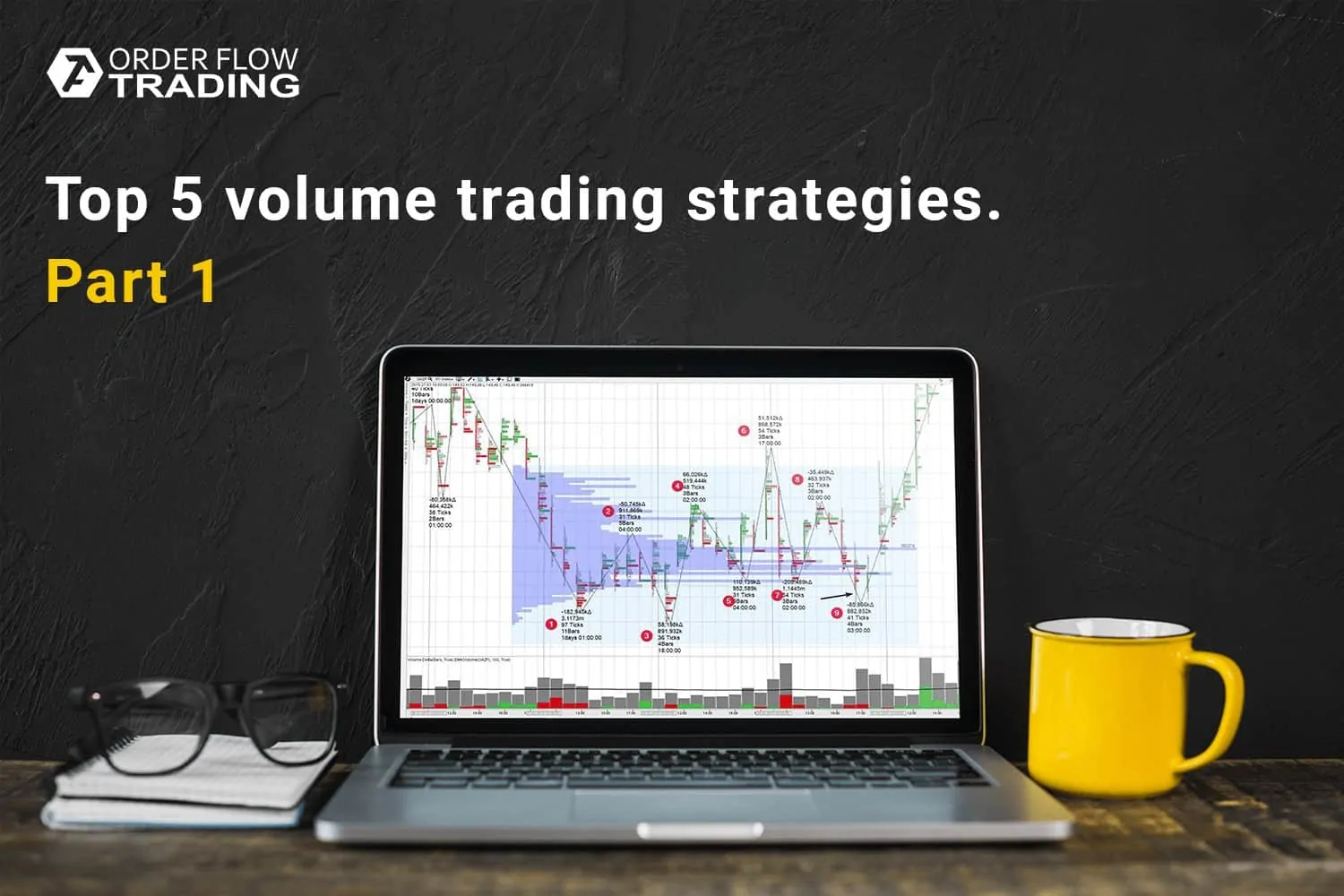
Mass trading strategy is unitary of the most popular search queries. Google produces more than 77 billion results for this interrogation.
Start to use ATAS absolutely free of charge! The first 2 weeks of use of the platform give access to its full functionality with 7-twenty-four hours history limit.
To try on ATAS gratis
And it is not an unwarranted interest.
Study of the mass trading strategy extensively develops beginners. Future traders learn to:
- read charts and understand the market. Even negative experience is useful. If you learn that something does not work, you cut it remove and become nigher to the knowledge of what really works;
- keep field and control risks;
- develop plans and respect money management.
Assortment of strategies
All strategies, with foreordained reservations, could be divided into 5 types:
- Trading in a range.
- Trading of a mistaken breakout.
- Trading on a break.
- Trading connected a trend rollback.
- Trading against a trend.
It could be conditionally stated that the first two are flat strategies, the next two are trend strategies and the terminal one is a counter-trend scheme.
Volume trading strategies are not an exclusion. The to a higher place categorisation is also true for trading with application of volume indicators.
In this article we bequeath consider each of the strategy types and talk about:
- principles of their use;
- signals for ingress into a perennial and sell on the basis of bunch up and volume psychoanalysis.
Each of the strategies leave contain a graph example from the real-life grocery store. Apart from a standard indicator of exchange volumes, we use the following instruments:
- Delta ( what Delta is );
- Zig Zag Pro . To stimulate ideas for using the Zig Zigzag indicant, interpret the clause about Weiss Waves ;
- Market Profiles ( what the Grocery store Visibility is );
- Cluster chart . This is a progressive case of presentation of information about the course of grocery store trading, which reflects activity in the class of clusters ;
- Fibonacci Levels ( how to trade using Fibonacci retracement levels ).
Let's make an important statement before we start our review of intensity trading strategies .
We leave not consider the general market context in to each one example. In material trading, it is important for a trader to hold bac in mind the current market Department of State from the orient of view of a general motion-picture show. Still, if we get laid, the clause would beryllium also long and prejudiced.
Our goal is to collect respective trading strategies and show the system of logic of latent trader's actions and practical methods of use of the ATAS program instruments.
Value judgement is applied in the strategy word. If you look to a strategy of the 'deal out when the bolshy lamp is connected and bribe when the green lamp is happening' type, this clause is not for you. We agree with a forgotten expert of the lineage market George Selden, who wrote in the beginning of the 20th century:
"I believe that the desire to observe a oblong mechanical formula takes responsibility for the majority of losses along the commutation".
One more affair. All trading strategies, which are considered promote, are universal ones, which work in any markets/periods, of course, taking into explanation particularised features of each instrument. Setups could beryllium pictured in the charts in an continuous turn of variants, but the basic principles (much as demand and supply, and effort and leave) stay the same.
No. 1. Volume trading strategy. Trading in a drift
System of logic. The strategy of trading in a range means that the commercialize is inactive and the Libra the Scales of demand and supply is stabilized. A trader doesn't anticipate that the situation would change radically in the approach future and decides to trade from the support and resistance levels, which manifested themselves in the chart:
- buying from the support level (get down boundary of the range) with the aim of take profit at the resistance dismantle;
- selling from the resistance level (upper boundary of the range) with the aim of take profit at the support level.
Example. Buying Gazprom stock.
The Gazprom stock formed a long-term support level of about RUB 150 in November-Dec 2022. When the price moved down to this level in March 2022, the securities industry became interesting for those who believed that the Leontyne Price would reverse up and enter the same range with peaks at about RUB 165.
We will consider the March reversal into the range from the support of RUB 150 in an time unit timeframe chart (remember that it is done without analysis of the general historical linguistic context).
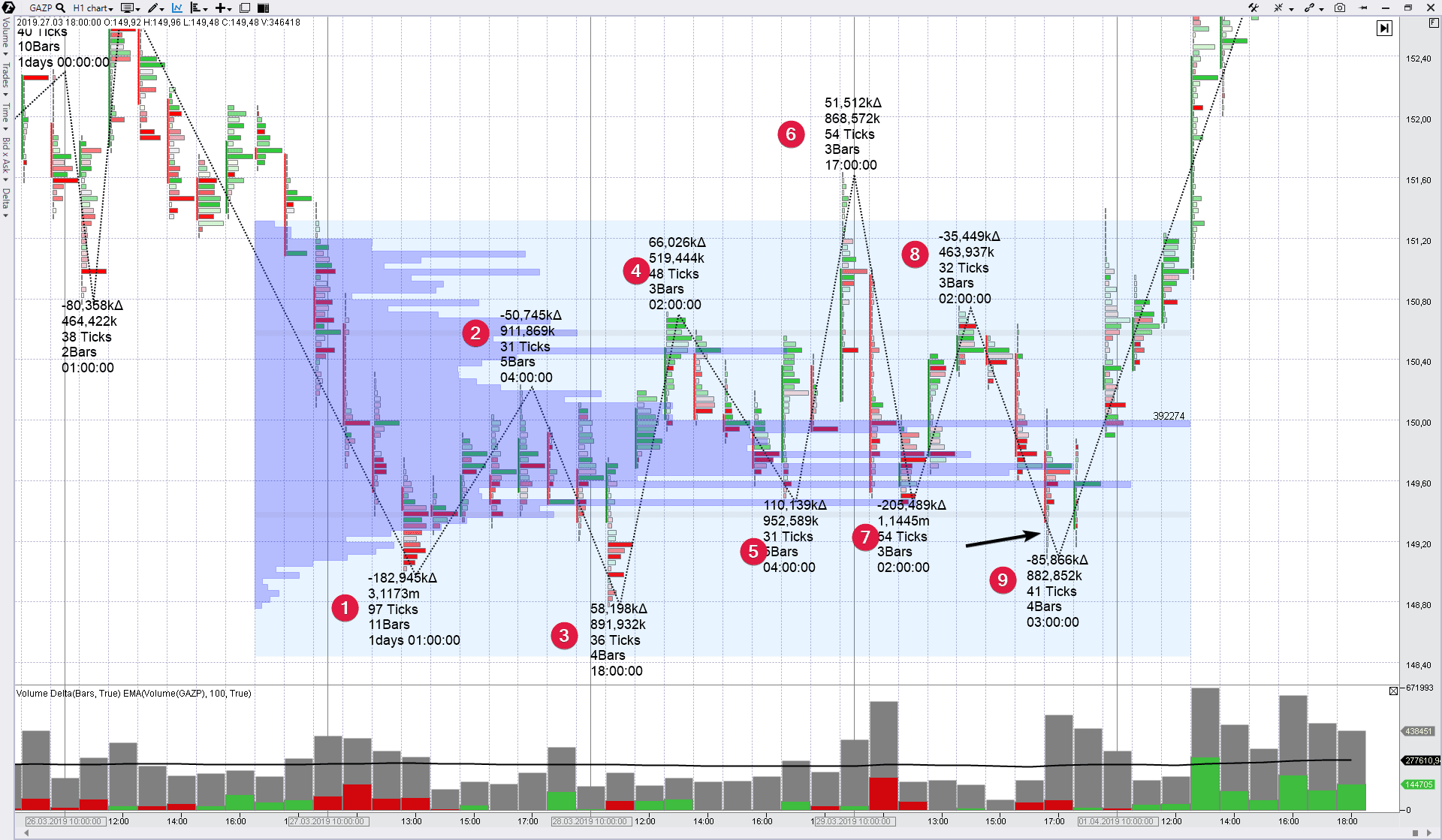
The chart has the following indicators: Zig Zag Pro , Delta (the difference between buys and sells) and Market Profile, which covers the volte-face area.
How should a trader sympathize that a real setback from the round support level of RUB 150 takes place with sexual climax back to the range, which acts along long periods? To build his psychoanalysis on facts.
- First fact. Absence of the market's wish to develop diminution of March 28 (bottom of wave 3) and fast restoration to the day's highs above 150. This provides a ground to assume that massive red clusters at the wave 1 small is Terror Merchandising , which, as a rule, ends the downward movement and starts formation of the upwards reversal. And bottom 3 is just a trap for bears who helpless in this position.
- Second fact. Beckon 9 has the lowest volume (882 thousand) among the previous downward waves. This allows to take up that the selling pressure is exhausted and the market is short of a 'fuel' for downward movement. Most probably, the panic sells, caused by step-dow of price quotes on a lower floor the scientific discipline level of 150, have been engulfed and the market is not interested in the foster downward movement. The arrow shows how the downward rear end becomes thinner on the clusters. On that point are no traders at that place who wish to sell low.
- Third fact. A strong opening with a minor upward gap on Monday on April 1.
- 4th fact. The profile looks like missive 'b'.
Using the above facts a trader makes a conclusion that the market has fewer chances to break the POC (Manoeuver Of Moderate) level some 149.5-150 and, most probably, IT would go higher. This is how the entry into a long position after the market opening connected April 1 is justified.
The stop could equal assumed below the low of the reversal formation, read, to 140.40. The aim is the previous highs around Hitch 165. An approximate relation of reward to risk is 4.5-1.
Good example 2. Selling a EUR futures.
Events of the last of June 2022 provided us with a setup for trading of the reversal from the resistance level. We speak some the market of EUR futures contracts .
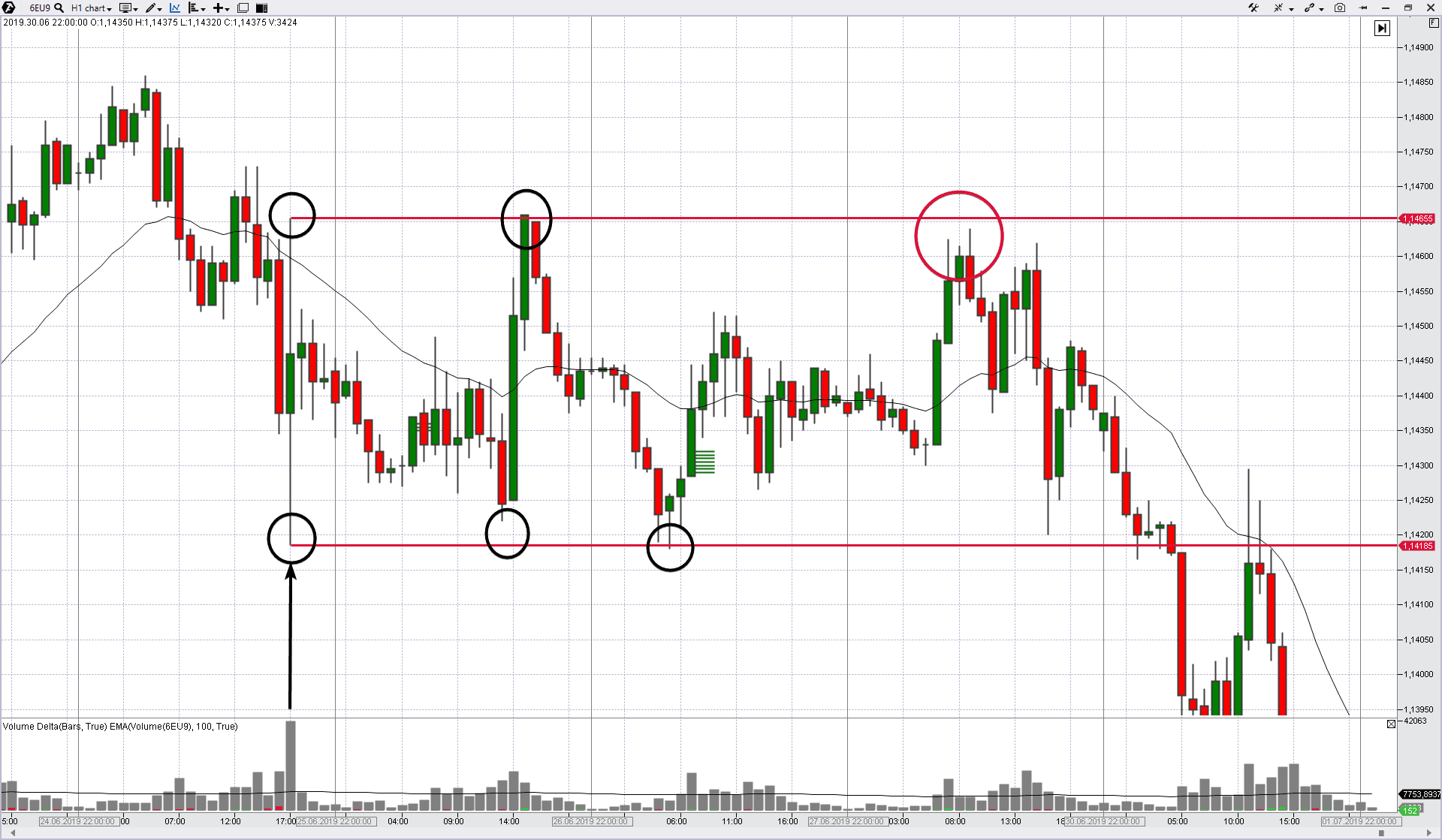
The Chairman of the Board of the Federal Reserve Arrangement Hieronymus Powell made a speech on Tuesday June 25. We will not talk over the issue of the speech, just note that the securities industry perceived this event selfsame smartly. The arrow points at the candle with a screechy volume and marks the market reaction at the second when the Chair of the Union Reserve made a speech.
Figuratively speaking, 'simmering' started after a thundering splash. The price tested distant points of the 'news' candle respective times during the next two days and returned to the balance, having formed the clear wander contours.
The colorful elliptic shows approach to the upper boundary of the range on the third day – on Friday on June 28. Every bit we can see post factum, the price backward down. Merely we are interested in the process mechanics. Let's consider the reversal in contingent during a fast period.
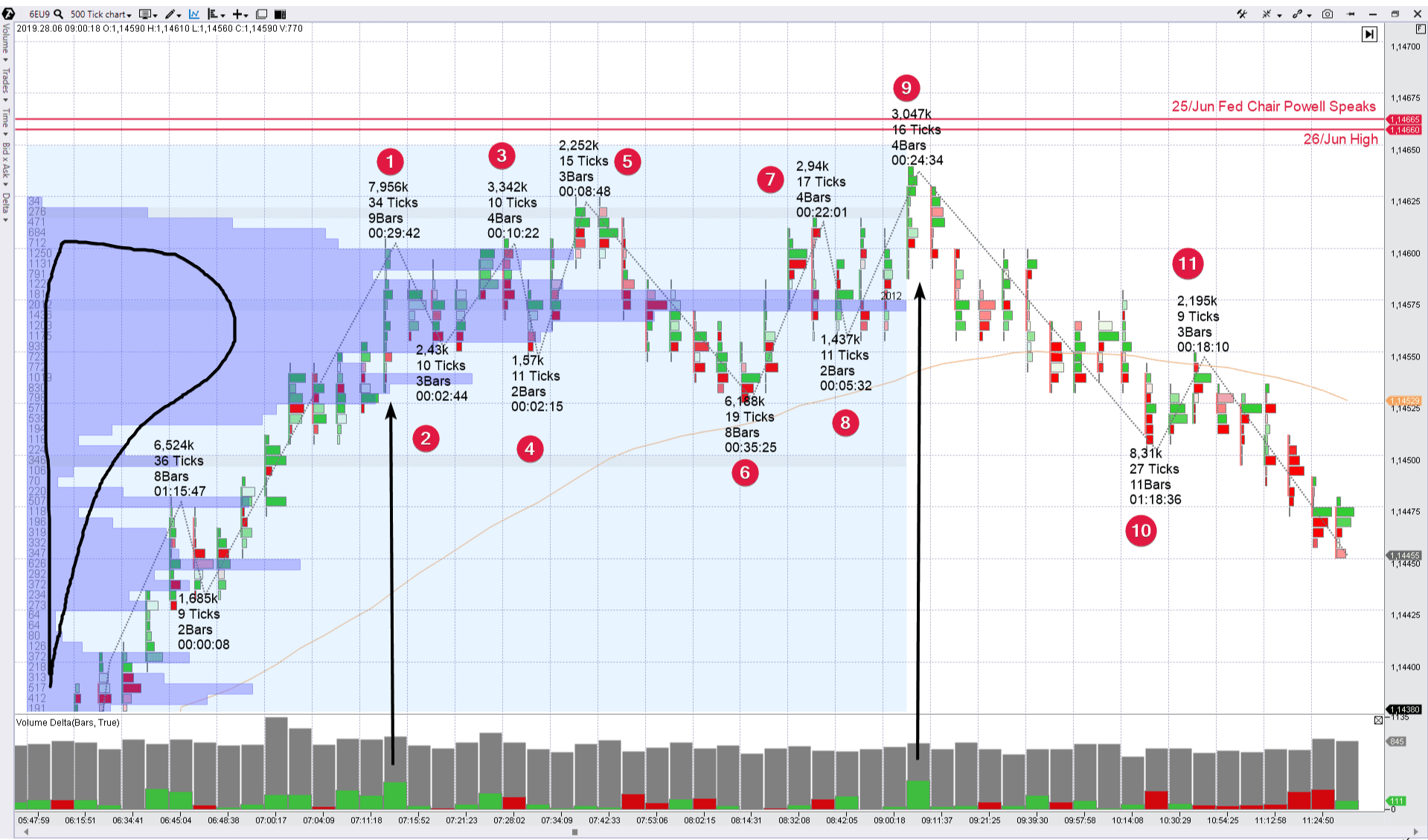
- The first pointer points at the Buying Panic of wave 1 with a splash on a positive delta. The price touched the level of 1.146.
- Unerect bowel movement developed after the panic and waves 2-3-4 were formed.
- Wave 5 is interesting because at that place is an obvious effort of buyers to push the Leontyne Price up through the highs 1-3 along its top. Simply the campaign failed. The buyers got stuck in a trap, instead of reaching a significant advancement, and watched with disappointment how waving 6 evolved.
- By the way, wave 6 has extension in scale both by volume and length and progress (compared to the previous downward waves). Information technology is a bearish sign.
- Zigzag 7-8 multiplied the convex shape happening horizontal volumes near 1.1475 even more. What does this miserly?
- Wave 9 gives a realise hint for a correct answer. It is yet another, but to a greater extent pronounced, failure of the buyers. The second arrow points at a significant effort of bulls. Many bribe trades were executed there. But the veridical progress was minimal. The price increased the previous local highs 5-7 by several ticks only. And transposed down just on the adjacent blockade. This trap for the buyers clearly demonstrates absence of the market's wish to exit upward from a short-term balance area (note the visibility formation in the fles of the alphabetic character 'p').
Consequently, if they do not lack to move up, we wait for their movement down. Resistance has totally chances to hold up. The time of the beginning of development of wave 10 is a take chances to enter into shorts.
Let's assume that we detected the change of mind in due time and:
- opened the merchandising at 1.14575;
- posted a stop loss behind 2 red lines at the level of 1.14710 (the risk is 0.002);
- set our destination nigher to the lower edge of the range, marked in the previous graph. Say, around 1.1425 (the reward is 0.005).
In this consequence, the risk-reward ratio would be 2.5. The setup was cast in the morning and the price reached its goal in the afternoon.
Succinct for the strategy of trading in a array
Let's draw some conclusions on the strategy of trading by reversals inside a range:
- The previous price action marks the range boundaries. Commonly, flats are particularized for the markets with a small number of price-forming factors or the periods, when the main exchanges are closed.
- Pay attention to those moments when the upward waves starting line to lose their force, while growing to the resistance level off, and the downward waves start to lose their force, while falling to the sustenanc level. Reduction of volume in a wave may separate the States all but weakness of traders that attack the level.
- In fact, downward reversals are small distribution areas and up reversals are weensy accumulation areas. You can read about accumulation and distribution areas in the respective article from the VSA and cluster analytic thinking cycle.
- Monitor the profile and bell-shape figure formation. More often than on average, the p-shape profile is formed at a downward reversal, while the b-shape profile is formed at an upward reversal from the musical accompaniment level.
- To find an entry point, pay attention to the colour change at the delta or to the price reaction to major clusters (for example, a breakout of the maximum volume of the previous banish).
- Look for a reward-risk ratio in your favour, which should non personify little than 2:1. So much a model would allow to be on the irrefutable side even if the copulation of gain-making trades to loss-fashioning trades is 50 to 50.
The strategy of trading reversals from the corridor boundaries is closely connected with false breakouts. The reason, as a rein, is that a setback is a little more complex social organization than a false breakout . That is wherefore, the former quite a frequently contains the latter (but not necessarily).
No. 2. Volume trading strategy. False breakouts
Logic. Beginner traders oft notice that the market as if purposefully 'picks up' their hold on losses ahead starting to move in the slump direction. It irritates when you make a correct forecast but hit losses in any case. This happens because the majority of traders (as if they came to an agreement) post their stop losings in obvious places. As a rule, these are the previous extreme points.
Trading false breakouts envisages that the cunning food market is interested in activation of stop losses of the crowd. Doing this way a major musician can grab liquidity and improve his positions. That's the way the market operates.
There is a back slope in this inedible game for the biggest money in the world. Ready money there, where others lose. That is why the ability to trade faux breakouts (massive activation of stop losses behind the obvious extreme points) allows entering the market with a profit there, where the majority of traders exit the grocery with a loss.
Example. Selling a gold futures
Let's consider the gold futures exchange , tick graph, 1 candle = 500 ticks.
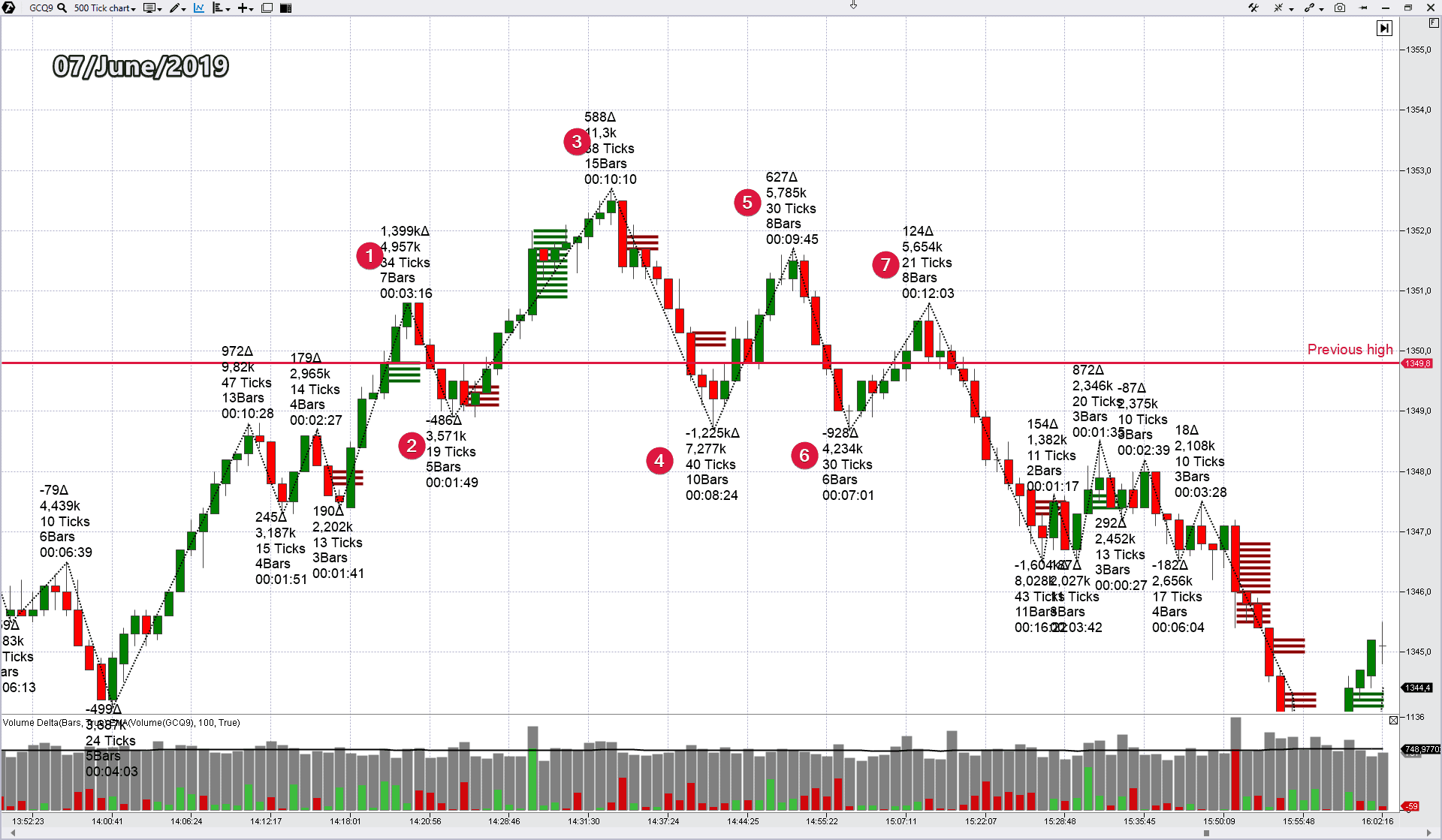
The gold market undertook an effort of a optimistic jailbreak of the previous day's high on June 7, 2022 (the level is conspicuous with a scarlet line of business). A splash of buys was registered on the wave from point 2 to point 3 (you can see it in the bottom cake chart at the green delta). The Imbalances indicator also sends 'loud' signals (green lines finally of the beckon). This wafture 3 'accumulated' the total book of 11.3 thousand contracts. It seems like the market is well-set and it plans to develop the success. However, it was too evident to be true…
Waving 4 completely 'swallowed' the moving ridge 3 growth progress. The Imbalances indicator too sharp changed its behaviour, registering an unexpected overweight of Sellers. Is anything wrong? The suspicion brings us to the approximation that this breakout is delusive.
Wave 5 confirms this idea, since it has a 'minute' cumulative loudness, just 5.8 thousand contracts, which is 2 multiplication less than the previous growing roll 3. Perhaps, the ontogeny to sharpen 5 reflects the ' no demand ' situation.
So, everything is correct. The splash of buys (and activation of Imbalances) on the movement of ( waving? ) 3 reflects activating of stop losses of the sellers (and also entering of untested buyers into a provident; baritone quality requirement). Such an activity doesn't create a perspective for a sustainable growth, that is wherefore the entry into a short becomes demythologised. You can open sells on wave 6 with the block up neighboring the clear of Wave 3. The goal is to renew the day's under near 1,334. An approximate repay to risk ratio is 2.5-1.
Download ATAS and check whether the profile forms the 'p' shape. If then, on what waves?
Example. Buying a USD/RUB futures
Rent out's consider a recent false breakout of the low in the futures exchange of the USD/RUB currency pair.
The 2-minute chart below shows a cluster view of the run over of trading in the morning of June 27, 2022. The red line Marks the local low of the previous day (it was formed at the level of 63,708 on Wednesday on June 26 at 19:30).
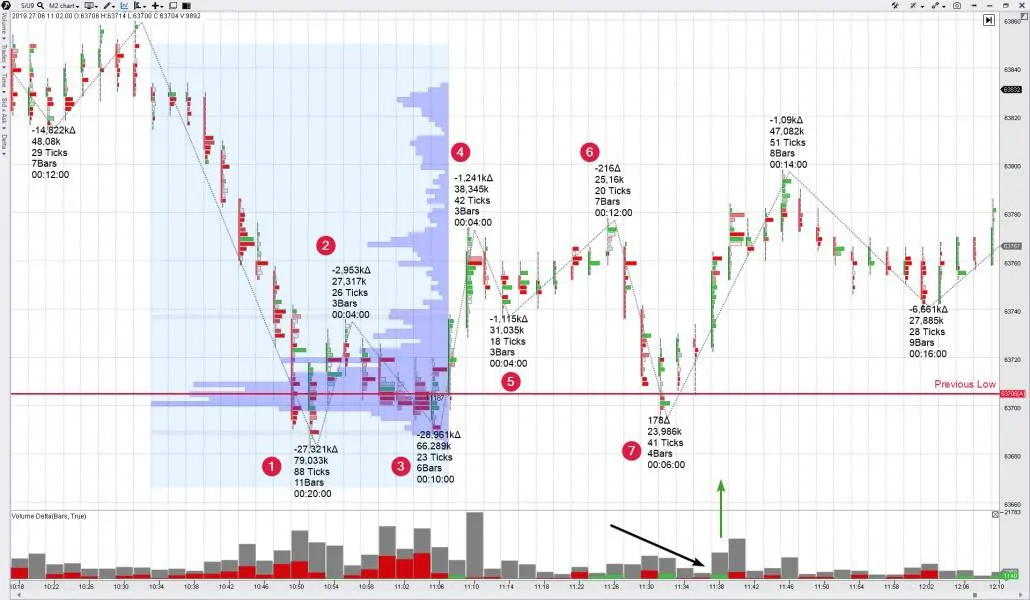
Activity in points 1-2-3 formed two thrusts of the early local anaesthetic soft (IT is scarred with the Bolshevik horizontal line). It's interesting that the volume happening the descending wave 3 is very high – 66 thousand contracts were listed. And these were mostly sells, which fire be seen from the delta. However, the progress for Sellers is not big. Wave 3 has the high-bass of 23 ticks only, which is respective multiplication less than the similar value on the premature downward wave – 88 ticks. Whereas, the volumes (79K and 66K) are quite comparable. A convexity in the mannikin of the letter 'b' (it is expanded in our graph) was formed in the market profile as a result of inertia.
If 'ferocious' sells on wave 3 reflect admittedly pressure of sellers, why did the future wave 4 closed above the high 2? It means that the activity in the area of the previous local lows 1 and 3 is an activation of stop losses of buyers, who had hidden their protective orders in a much too obvious place. Also, the sells were provided by traders "for a breakout of the support".
Wave 7 shows the decreasing volume of 23.9K. The bears 'tail assembly off'. There was a test of the Point Of Control visibility, plotted on the chart,dannbsp; from the point of view of an analyst of flat volumes. The black transmission line in the bar graph is yet another confirmation of the 'tiredness' of bears. It reflects the fading kinetics of the traded volumes. This is, out and away, not that activity, which was noticed at lows 1-3.
That is why opening a long near low 7 or at the beginning of moving ridge 8 is non a bad space for buying. The green pointer points to a strong bar (a splash of loudness on a positive delta), after which the entry becomes a bit overly late.
Army of the Righteou's assume:
- buy in – 63,720;
- block – 63,660 (60 ticks);
goal – 63,860 (140 ticks) – at the level of the local full, from which the wave (1) came down. The goal was reached at 12:40 in this case.
The reward to risk ratio is 2.3:1.
Summary for the false prison-breaking strategy trading
The outcome for the off-key breakout trading strategy is, in universal, similar to the outcome for the reversal strategy. Wherefore? Because both strategies discover the 'non-breakout' grocery activity in the area of significant support/resistance levels.
- Look at the previous monetary value action when you swap untrue breakouts. Information technology marks localized extreme points. Stop orders of a multitude of modest traders accumulate in that respect in run of time.
- A splash of volume takes billet on the thrust taproo, however, the price rolls back deeply subsequently the thrust.
- Ill deltas at the resistance thrust mean activation of stop losings of the Sellers and entry into a trap of thin-minded buyers. The opposite is straight – red deltas at the confirm push up mean activation of diaphragm losses of the buyers and entry into a trap of light-minded Sellers.
- A false breakout could take out place not only at the level of the previous extremum channelis. A 'subversion' whitethorn take place when carrefour a fill out figure. Say, USD 200 for a AAPL share. Operating room USD 200 for a TSLA divvy up. Round levels serve, in themselves, A significant support and resistivity levels.
- Reminder the profile. Formation of a 'convexity' reflects activity, when traders, who believe that the prisonbreak is true, enter into the positions, which would kick out to be traps. A p-shape visibility is formed at the downward reversal to a greater extent often than on average. A b-soma profile is formed at the upward black eye from the defend.
- An entry signalise could be sent by indicator data (for example, if the delta changes its colour) operating theatre by the price/clusters action. Make judgements on the basis of facts in order to catch the beginning of a fluctuation, which has a linear perspective to develop into a significant wave. Make money there, where others suffer. Retain the reward to take a chanc ratio in your favour – not to a lesser degree 2:1.
- False breakouts claim direct Sir Thomas More often at the moments of high unpredictability – when sessions are opened or news is broadcast.
In rank to get more information about false breakouts, read about VSA upthrusts and cluster analytic thinking .
Summary happening flat strategies
The described 2 strategies – for trading at reversals and false breakouts – are the near suitable for working in the markets, which trade a range. For example, if a consolidation emerges at longer timeframes, monitor the price action when it reaches topical extreme points at shorter timeframes.
The main difference between the setback trading and false breakout trading is that a reversal is a more complex process, while a false breakout could be just a 'cursory' spatter.
We volition still talk over this difference but a bite later. Don't miss the second part of the article on volume trading, where we will talk over the following strategies:
- Trading happening a breakout.
- Trading happening a push back.
- Trading against a movement.
In the meantime:
- download ATAS free of charge;
- arranged the Delta and Zig Zag indicators in the cluster chart;
- tick the closest keep going and resistance levels at the 1-hour point;
- mark alerts at these levels ;
- watch attentively the waves and deltas when the alerts activate.
We Hope this information was useful for you. Follow our publications and click like button.
Понравилось? Расскажите друзьям:
Другие статьи блога:
trading strategy examples fundamental analysis
Source: https://ATAS.net/volume-analysis/strategies-and-trading-patterns/top-5-simple-volume-trading-strategies/
Posted by: ybarracopievere.blogspot.com

0 Response to "trading strategy examples fundamental analysis"
Post a Comment